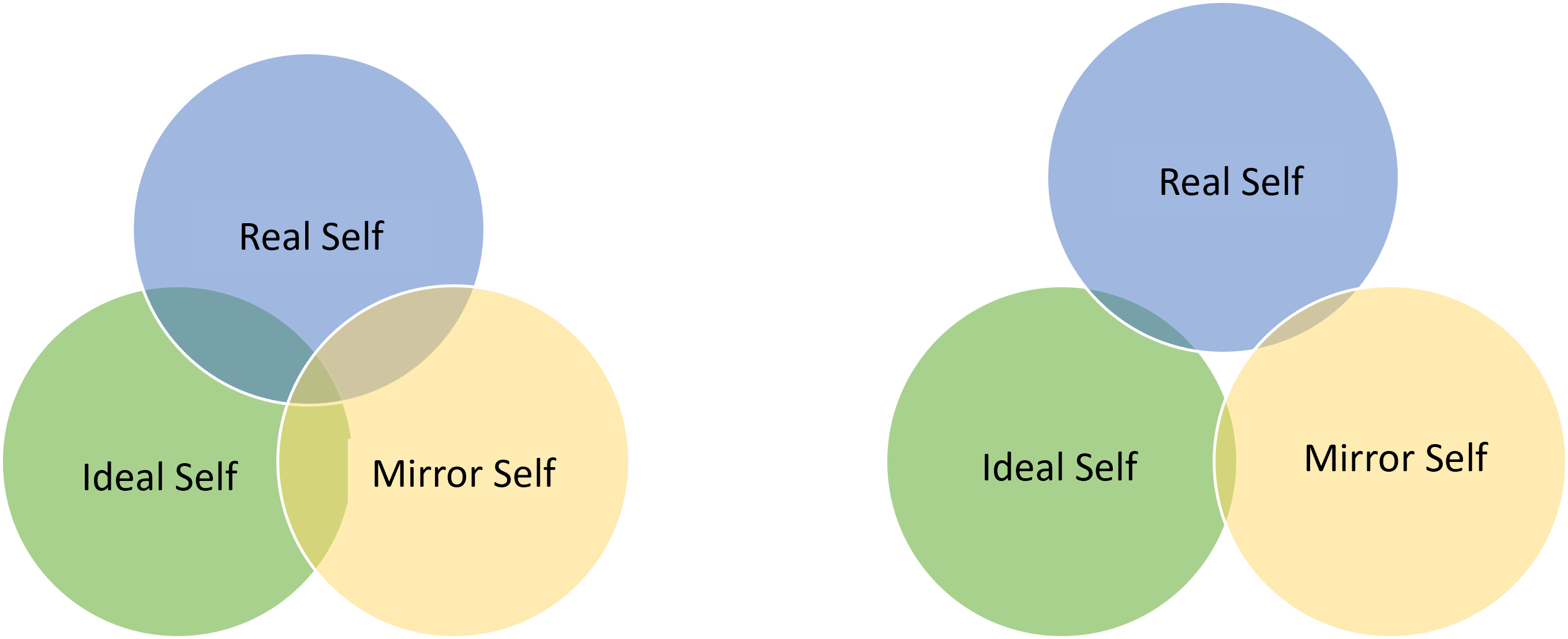SYMBOLIC INTERACTIONISM
Our self-image, which is central to how we interpret and handle the situations we find ourselves in, can be divided into three different parts.
a
- Real me, which reflects how I actually perceive / see myself.
- Ideal self, which is about how I want / wish to be. If the personal goals are realistic, they can be goals to strive for.
- Mirror me, which is about how I think others see me, which can for example mean that I try to live up to what I think is an expected image of me.

The cohesive/integrated self-image
When we have a coherent/integrated self-image, the difference between the different “I’s” is small, which means that we become more “controlled from within”, our own thoughts, feelings, needs and values control us in the current situation.
If my real self says that I am important and that is also how I perceive that others in my environment see me (the mirror self), it gives me a positive, realistic, and well-coherent self-image that will contribute to a strong self-esteem.
If I have created a realistic ideal image with well-thought-out and actively chosen values, with a calibrated compass, it will help me to be more “directed from within”
The fragmented self-image
When we have a split self-image, the difference between the different selves is large and I become more “controlled from the outside”. Which means I will try to “read” and live up to other people’s expectations, “turn my coat to the wind”?
Maybe I feel less important at the same time as I also perceive that other people do not include me the way I want If my wish is to “belong” this will itself affect my self-esteem and the probability is high that I will act “controlled from the outside”. If I am unsure of, or unaware of, what values I have or want to have, this will increase my uncertainty about being “controlled from within.”
A fragmented self-image often leads to shame and feelings of guilt.
 Sending...
Sending...
ANVÄNDARVILLKOR
TJÄNSTEN
Great Course är en tjänst som hjälper företag och organisationer att skapa digitala kurser och utbildningar. Vid köp av digitalt material som är framtaget med hjälp av Great Course AB gäller följande villkor
REGISTRERING AV KONTO
För att ta del av en kurs som skapats med hjälp av Great Course tjänst måste du registrera ett användarkonto. Du ansvarar själv för att dina uppgifter är korrekta samt att ingen annan får tillgång till dina inloggningsuppgifter eller ditt lösenord. Skapande av ett konto medges endast den som har en giltig mejladress. Efter genomfört köp skickas inloggningsuppgifter och kvitto till angiven mejladress. Du får därefter tillgång till materialet. Kontakta admin@greatcourse.se om du inte får dina uppgifter eller om du har andra frågor angående teknisk support.
BETALNING
Betalning sker i samband med ditt köp. För hantering av kortbetalning använder vi oss av Stripe. Vi accepterar: Visa, Mastercard och American Express. Inga kortuppgifter lagras hos oss, utan sparas endast hos Stripe. All korthantering sker SSL-krypterat (Secure Socket Layer) vilket innebär att all kommunikation mellan oss och Stripe är krypterad, så att du tryggt kan fylla i dina kortuppgifter och genomföra betalningen. För Stripes betaltjänster gäller Stripes allmänna villkor och sekretess-policy. Om din kortbetalning nekas får vi ingen information om varför ditt kort inte fungerar i systemet. Kontrollera dina kortuppgifter och försök igen eller använd ett annat kort. Om det fortfarande inte fungerar kontakta oss på info@bolaget.se
PRISER
Alla priser visas inklusive moms, även priser riktade till företag.
ÅNGERRÄTT
När du köper digitala produkter gäller inte distanshandelslagen. Då betalningen gått igenom och du fått tillgång till materialet anses ångerrätten förbrukad. Om en kurs inte fungerar eller är felaktig är du istället välkommen att kontakta info@bolaget.se
TEKNISKA FÖRUTSÄTTNINGAR
Tjänsten kräver tillgång till internet samt en uppdaterad webbläsare. Du ansvarar själv för de kostnader som uppstår i användandet av internetuppkoppling.
TILLGÄNGLIGHET
Materialet du köpt finns tillgängligt dygnet runt, sju dagar i veckan. Great Course ger dock inga garantier för att tjänsten alltid är fri från fel eller avbrott. Om brister eller avbrott i tjänsten uppstår skall Great Course ges möjlighet att rätta till dessa utan att avtalsbrott skall anses föreligga. Great Course har också rätt att, i rimlig omfattning, stänga tjänsten för till exempel uppgraderingar och service.
ANVÄNDARENS ANSVAR
Allt innehåll som tillhandahålls i kursen ägs av kursskaparen och skyddas av upphovsrätten. Genom att köpa en kurs erhåller du en icke-exklusiv, icke-överlåtbar, begränsad licens till kursen. Användarvillkoren innebär inte att äganderätten eller andra immateriella rättigheter till innehållet i kursen överlåts till dig eller någon annan. Ditt konto och dina användaruppgifter är personligt kopplade till dig och du ska inte dela med dig av dem till andra. Du förbinder dig att inte, vare sig helt eller delvis, kopiera kursen eller annat innehåll i Tjänsten samt att inte på något sätt åsidosätta de tekniska begränsningar som är avsedda att begränsa möjligheten att kopiera innehåll eller sprida vidare kurserna eller annat av innehållet i Tjänsten genom exempelvis försäljning, kopiering, utlåning eller uthyrning, inte ens för eget bruk.
FORCE MAJEUR
Händelser utanför utbildnings kontroll, vilken inte skäligen kunnat förutses, ska hänföras till force majeure, vilket innebär att företaget befrias från sina förpliktelser att fullgöra ingångna avtal.
KONTAKT
Frågor kring dessa villkor riktas till:
Ansvarig för betalning och kursinnehåll: info@joyfulgroup.se
Tekniskt ansvarig: admin@greatcourse.se
Terms & Conditions
Terms of purchase example
 Sending...
Sending...
